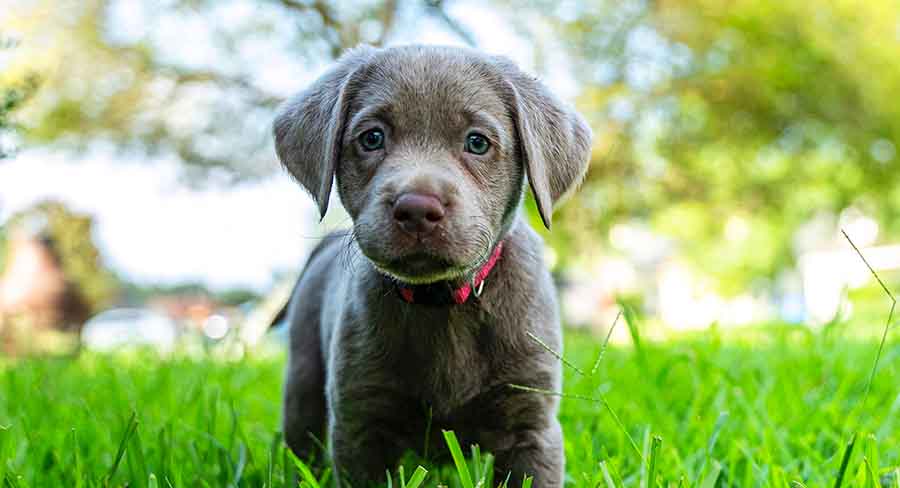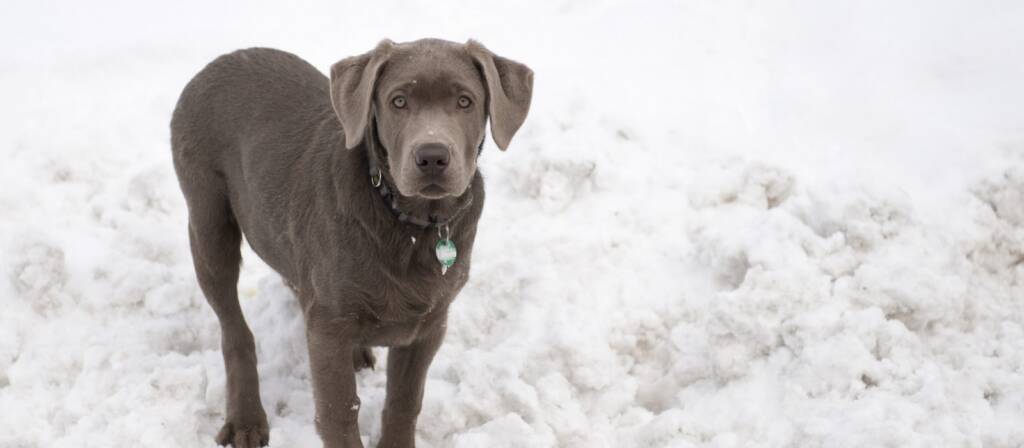More commonly known by the name a silver labrador, a blue Labrador is a blue Labrador. There has been a lot of controversy regarding this coloring in the past, as it does not meet Labrador’s breed standard. The condition is caused by dilute genes which decrease pigmentation in the fur of a chocolate Labrador, therefore giving their fur a silvery-blue appearance. There is a small minority of Labrador enthusiasts who believe that it is not appropriate to breed silver-blue Labs since they believe this color is the result of mixed breeding, somewhere in the Labrador lineage. The truth is, many people find these Labradors to be wonderful companions.
Do Blue Labrador Retrievers Exist?
It is important to note that Labrador’s breed standard recognizes three acceptable colors for the dog – it is acceptable for the dog to be black, chocolate, or yellow. As you can see, there are various shades of pigmentation among these, but you will continue to see your chocolate Labrador as brown all the time. This means that according to the breed standard, a blue Labrador is impossible to find.
All dog breeds, however, have some individuals that do not quite fit the breed standard, for example, if their coloring, size, or other characteristics do not conform to the breed standard. It is possible that some Labradors can inherit genes that can cause their coats to turn silver (or blue) in color. This coloring is quite uncommon because the genes to produce it are recessive and many breeders avoid breeding silver Labs due to the recessive nature of the genes. Additionally, some people argue that these dogs are not purebred Labrador retrievers at all. There are labradors with blue or silver coloring, as well as Labradors with brown or chocolate coloring.
Blue Labrador Genetics
Dogs have only two basic pigments that make up their coats – eumelanin (black) and pheomelanin (red). There are two recessive b genes (bb) in labradors that must be present for them to have brown fur. To further transform this coloring into a silver, Labs are required to inherit another recessive gene at the dilute (D) locus before they reach this point.
For a lab to have a silver or blue coat, it must receive two recessive d genes. This means that from each parent the gene must be inherited. This means that if they do not inherit the gene from both parents, they will have a brown coat. In some cases, a blue Labrador can come as a complete surprise to some pet owners as recessive genes can be carried over generations without showing up.
What Is the Appearance of a Blue Labrador?
The fur of a blue Labrador will be silvery gray. This is another name commonly used to describe silver or gray-colored dogs. Most commonly, blue labs are referred to as silver labs. Despite this, they will still resemble a Labrador in every other aspect other than the color of their fur – provided they are not a mixed breed.
Consequently, they should stand somewhere between 21.5 and 24.5 inches tall and weigh between 55 and 80 pounds. Generally speaking, the females are smaller than the males. They can be recognized by their short, dense fur that is made up of two layers, their otter tails, and floppy ears.
In addition to the dilution of coloring, certain forms of alopecia are also associated with it. The result is that your blue Labrador may have patches of thinning fur or patches of no fur at all.
Are Blue Labradors Purebred?
It is quite controversial to many breed enthusiasts whether or not Labradors are silver or blue. Some claim that it is a natural trait of the Labrador breed resulting from the early standardization of the breed. It is not uncommon for many silver labs to have papers documenting their purebred ancestry which dates back to many generations. It is also possible to dilute the coloring of black and yellow fur to the point where it turns lavender and champagne in color.
Others, however, believe that it can only be the outcome of mixed breeding. It would be interesting to introduce another breed that has a blue coat, like the Weimaraner.
A certain thing is that some disreputable breeders try to sell mixed breed Labs as purebred silver Labs to unsuspecting breeders. It is because of this that they can market certain colors of fur as “rare” and charge a high price for them. It is important to choose a reputable breeder when buying a purebred dog because purebred Labs tend to have diluted coloring. To ensure a healthy and happy dog, health should be the priority over the color as a good breeder will give good care and attention to your dog above all else.
Can Blue Labradors Make Good Pets?
The Labrador dog breed is a large, energetic dog breed. They need daily exercise, training, and socialization from the time they are very young, and they need plenty of company. The dogs are very people-oriented, so they do not do well when left alone for prolonged periods. If left alone for an extended period, they may behave in an unwanted manner. On the other hand, not providing sufficient physical exercise and mental stimulation can lead to boredom and its related undesirable behaviors.
As labs in general, Blue Labs will be prone to the same health issues as other Labs, such as joint problems, ear infections, exercise-induced collapses, and so on. In addition to this, they may also be at risk of color dilution alopecia, which causes their fur to thin out.
There is a possibility that the blue Labrador you select is a mixed breed, in which case its traits, care requirements, and health will differ depending on the other breed that was used. For this reason, you should look up the specific mix to find out more information about their suitability.
Where Can I Find a Blue Labrador?
It might be the case that some breeders specialize in producing Labradors with diluted coat coloring. The truth is, a silver-blue Labrador can come as a pleasant surprise in many cases. It is easy to distinguish the blue puppies from the chocolate puppies from the moment they are born as they will have blue fur from the time they are born. To gain a quick profit, disreputable breeders may jump on these trends, so you should be wary of any breeders who are marketing their puppies as “rare” or “special” – especially if they are selling these puppies at a higher price than normal.
It is not possible to compete in shows with a blue Labrador, since they don’t fit the breed standard, and there are health complications that can accompany this coloring. For these reasons, breeders should not increase the price of blue Labrador puppies. There are even some breeders who may drop the price of their puppies – especially if their other puppies are also of show quality.
If you are choosing a breeder, make sure that you do plenty of research and ask plenty of questions. Check if there is any evidence of health testing, and make sure you check out where the mother dog and puppies are being kept. In addition to being loved and cherished members of the family, they should look healthy and happy as well. It is important that they also show a sense of confidence and friendliness. You can expect the best breeders to ask you plenty of questions in return to ensure that their puppies go to the right homes. They may also wish to discuss the additional issues associated with silver coloring in laboratories.
Blue Labrador – A Summary
There is no doubt that the silver or blue Labrador Retriever is a controversial dog. While it is not considered a show dog, it can make a good family pet, just like any Labrador bred for companionship. It is, however, associated with certain health problems as a result of its dilute coloring. You may also come across bad breeders that are trying to missell mixed puppies to make a quick profit. Make sure that you do lots of research before deciding on whether to get a silver or blue Labrador Retriever!
Chocolate Lab eyes are either brown, or hazel. The closest you can get to blue, and very unusual and distinctive in their own right, is a chocolate Lab with hazel eyes that have a high proportion of green.
Since the genes required are recessive, and many breeders will avoid breeding silver Labs, this coloring is quite uncommon.


